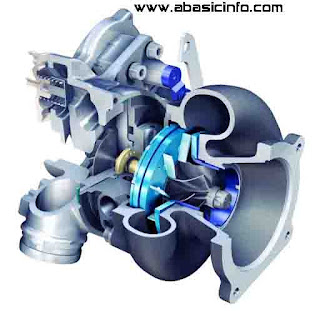To understand turbos, you need to know the basics of how an engine works. Consider an engine like a large pump. It sucks air and fuel into a cylinder, compresses and combusts them, and then pumps out all the goodies that folks wish to get angry about. To produce more power from an engine, it needs to burn more fuel quickly. Getting fuel is usually as simple as turning the tap up, but unless there’s also more air, that extra fuel is useless. A cylinder is restricted in the proportion of air it can breathe by its size or displacement.
When engine makers needed more air to mix with the fuel, they needed a bigger cylinder. There was no replacement for displacement. This made engines larger, heavier, and often slower to rev.
In 1905, an engineer named Alfred Buchi came up with a solution for this problem. He designed the exhaust gases of an engine to run a special compressor that then fed denser air into the combustion chamber.
More air helps fuel burn more efficiently and generate more power. Turbos were quickly adopted by the aeronautical industry. When you’re 20,000 feet up, the air is nearly half as dense, and engines would lose the maximum amount of power. Consider 400 horsepower at sea level. But moving up to 14,000 feet, it drops to 265. The turbocharger restored atmospheric pressure within the engine back to sea level. This is called turbonormalizing.
When a turbocharger is employed to exceed that pressure, that’s called turbocharging. When your engine expels exhaust gases, they enter Turbo. The exhaust air gets piped over this turbine and spins it sort of like a pinwheel. The exhaust passes through the turbine system and exits through the exhaust pipe. This turbine is connected to an impeller, and it spins too. When it spins, it suckers in lots of air through this inlet. Force the air into your intake manifold.
The air is now denser, so it has more oxygen, so it can burn more gas more quickly, giving you more power. Keep that charged air from going back to the turbo. When you take off the throttle, a detachable valve relieves the pressure. By letting the air return to the atmosphere. Turbocharging creates heat. The turbine side has direct contact with the exhaust manifold, making it glow like hot metal.
You may have noticed that this portion is appropriately mentioned because the hot side of a turbo often looks rusty. That’s because the acute heat acts as a catalyst, causing the metal to oxidize more quickly. This portion also generates heat.
The closer proximity of the air molecules as they are compressed results in friction. Once they start competing with each other, the speed of the air is then increased by all of these heated, electrified molecules. They become less dense as a result. Forced induction is designed to push denser air. The molecules will cool if we return all of this hot turbocharged air to its original temperature. grow progressively denser as they move closer together. There are several methods for doing this. The most well-liked and simple method uses an intercooler.
An intercooler sits between the turbo and the engine. The air passes through channels with cooling fins. The cool air from outside passes over the fins, which absorb the heat energy and reduce the temperature. We know that a turbocharger is an air compressor. If a turbo is too big, it takes an extended time for the exhaust to urge it to spin fast enough to compress the air.
The time between pressing the pedal and you feel the boost, is called lag. Engineers solved this problem by using two small turbos to push more air. There are multiple ways to put two turbochargers on an engine. Parallel turbocharging, sequential turbocharging, etc. The first commercially available twin-turbo car was the Maserati Biturbo in 1981.
This first production attempt at twin-turbocharging used the only method of applying two turbos to an engine. Parallel turbocharging. As long as there’s enough space within the engine bay, using two turbos is really easier than using one. When an engine is arranged such as a V-shaped engine. Each bank can have its own turbo, instead of routing all of the cylinders into one.
In Parallel turbocharging, two equally sized turbos are working 100% of the time. A sequential system uses a small turbo that spins up quickly until another larger turbo has to spin up. This method reduces turbo lag and gives smoother power delivery. To control the flow of exhaust to the correct turbo, a series of bypass valves opens and closes at just the right moment, ensuring the proper turbo spins at the proper time.
Turbocharging is a perfect example of performance technology. The 80s and 90s turbos helped a lot to design modern turbocharging.





